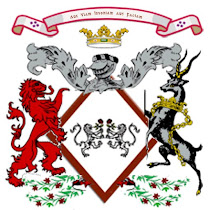
The Amber Room
Having intended to post on something entirely different today, I ran across the following kinescope from the future and knew that I wanted to post it (despite what is to be termed network morning news fluff at some point in time). And in posting it, I felt it only right to do a little more research for this readership and perhaps those of the Royal Society.
Now initially I tried to embed the moving picture here, but that was met with dubious success. Please find the ABC News clip at this location.
Summary
The Amber Room was created from 1701 to 1709 in Prussia and remained at Charlottenburg Palace until 1716 when it was given by Prussian King Friedrich Wilhelm I to his then ally, Tsar Peter the Great of the Russian Empire. The Amber Room was looted during World War II by Nazi Germany and brought to Königsberg. Knowledge of its whereabouts was lost in the chaos at the end of the war. Its fate remains a mystery, and the search continues.
The original room in the Catherine Palace in Tsarskoe Syolo near St. Petersburg was a complete chamber decorated with amber patterns atop gold leaf and mirrors. Due to it's singular and spectacular beauty, it has been called the Eigth Wonder of the World.
The Reconstruction viewed above in the kinescope was started in 1979 and was based primarily on very old black and white photos of the original room. In 2003 the new room was dedicated by Russian President, Vladimir Putin and German Chancellor, Gerhard Schröder at the 300-year anniversary of the city of Saint Petersburg.
Creation of the Original
The Amber Room was made from 1701 onwards in order to be installed at the Charlottenburg Palace, home of Friedrich I, the first king of Prussia, at the urging of his second wife, Sophie Charlotte. The concept of the room and its design was by Andreas Schlüter. It was crafted by Gottfried Wolfram, master craftsman to the Danish court of King Frederick VI of Denmark, with help from the amber masters Ernst Schacht and Gottfried Turau from Danzig.
It did not, however, remain at Charlottenburg for long. Peter the Great admired it on a visit and in 1716, the king's son, presented it to him, and with that act cemented a Prussian-Russian alliance against Sweden.
In 1755 Tsarina Elizabeth of Russia had it transferred and installed, first in the Winter Palace, and then in the Catherine Palace. From Berlin, Frederick II The Great sent her more Baltic amber, in order to fill out the originals in the new design by the tsarina's Italian court architect.
The Amber Room represented a joint effort of German and Russian craftsmen. After several other 18th-century renovations, it covered more than 55 square metersand contained over six tons of amber. It took over ten years to construct.
History and Mystery
This opulent gesture of friendship between Russians and Germans would come to serve as a potent symbol of their divisions. When Hitler invaded the Soviet Union in 1941, his troops overran Tsarskoye Selo, dismantled the panels of the oversized jewel box, packed them up in 27 crates, and shipped them to Königsberg, Germany (today's Kaliningrad). In January 1945, after air raids and a savage ground assault on the city, the room's trail was lost.
After the war, the German official in charge of the amber shipment said the crates were in a castle that burned down in an air raid. A Soviet investigator found a charred fragment from the room.
It seems hard to believe that crates of several tons of amber could go missing, and many historians have tried to solve the mystery. As noted above,the most basic theory is that the crates were destroyed by the bombings of 1944. Others believe that the amber is still in Kaliningrad, while some say it was loaded onto a ship and can be found somewhere at the bottom of the Baltic Sea. In 1997, a group of German art detectives got a tip that someone was trying to hawk a piece of the Amber Room. They raided the office of the seller's lawyer and found one of the room's mosaic panels in Bremen, but the seller was the son of a deceased soldier and had no idea as to the panel's origin. One of the more extreme theories is that Stalin actually had a second Amber Room and the Germans stole a fake.
Another bizarre aspect of this story is the "Amber Room Curse." Many people connected to the room have met untimely ends. Take Rohde and his wife, for example, who died of typhus while the KGB was investigating the room. Or General Gusev, a Russian intelligence officer who died in a car crash after he talked to a journalist about the Amber Room. Or, most disturbing of all, Amber Room hunter and former German soldier Georg Stein, who in 1987 was murdered in a Bavarian forest.
Despite all the intrigue surrounding the disappearance of this spectacular work of art - this gift -it must be said that the loss of the original dealt a blow to the Russian people and to the world at large. We are fortunate that we now have a facsimile of which we may partake.
The history of the new Amber Room, at least, is known for sure. The reconstruction began in 1979 at Tsarskoye Selo and was completed 25 years—and $11 million—later with primary funding from a German petrol company. The dedication of the new room marked the 300-year anniversary of St. Petersburg in a unifying ceremony that echoed the peaceful sentiment behind the original. The room remains on display to the public at the Tsarskoye Selo State Museum Reserve outside of St. Petersburg.
Swank & Co at Fantasy Faire 2022
3 years ago



0 comments:
Post a Comment